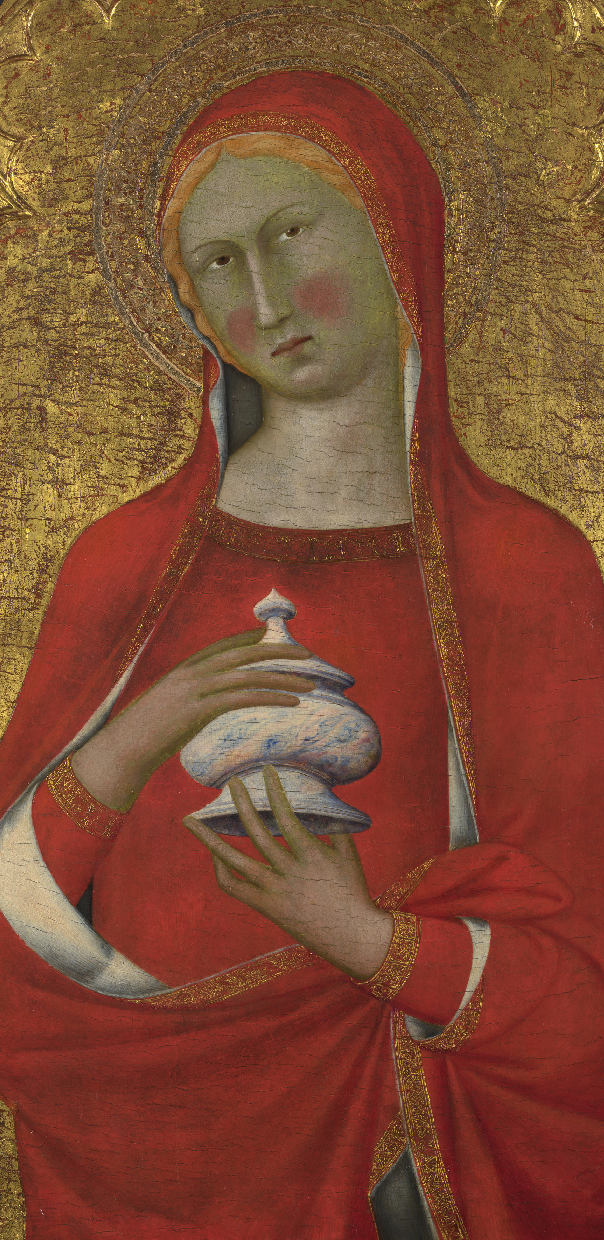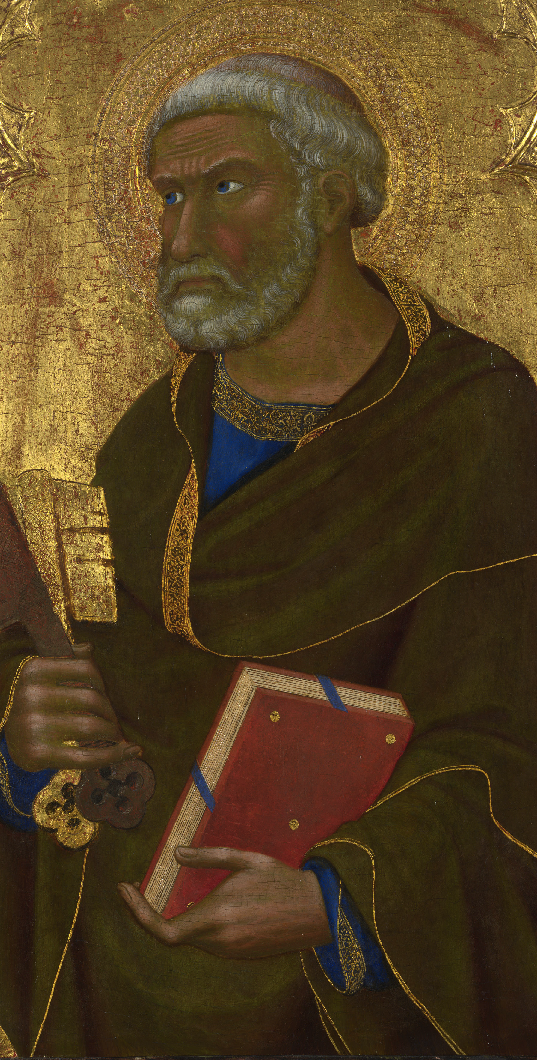
LIFE AS MYTH
![]()
JOURNAL
![]()
JOURNAL 2015
1001 stories
The gift of self
![]()
SUMMER 2015
Navigating dark waters
![]()
LIFEWORKS
![]()
ATLAS
![]()

SUMMER 2015
THE DARK NIGHT OF THE SOUL


Saint Mary Magdalene, Saint Peter from the Master of Palazzo Venezia Altarpiece Panel, artist unknown. 1350. National Gallery, London. The 'myrrh-bearers' is a group of first century women who assumed various roles in the events surrounding the crucifixion, entombment and resurrection of Christ. However, the most significant role of the myrrh-bearers is as first witnesses to the resurrection. Post-crucifixion narratives detail the discovery of the empty tomb by several women and their vision of an angel who announced the resurrection. Mary Magdalene is pivotal in these accounts as Christian texts identify her as the first witness of the resurrected Christ. During that encounter, he instructs her to notify the disciples of his return. Consequently, the Christian church recognizes her as "equal to the apostles" or "the apostle to the apostles".
Shrouded by the night
And by the secret stair I quickly fled
The veil concealed my eyes
while all within lay quiet as the dead
"The dark night of the soul" by Loreena McKennitt; inspired by the poetry and writing of St. John of the Cross[originally published Summer 2008]
Life evolves in seven year cycles. If you have lived long enough, you can probably identify them. Find a major event from your past -- a marriage or possibly a serious illness. Counting forward or back, see if you experienced another major Life event at the next seven year juncture. If you continue counting, a road map of your life emerges. I am at the end of a seven year cycle. This one was unusual in that the change and disruption, which is usually associated with the first and seventh years, have held steady throughout it.
This cycle probably marks the transition period between the first part of my life where I had all the answers -- to the second part of my life where I have mostly unaswered questions. A little explanation. There was a time when I could describe the paradigm for my life rather simply (to whomever might care to listen). Drawing a triangle on whatever was handy -- a paper napkin, a drugstore receipt, the margins of a takeout menu -- I would explain my life as wife, mother, and artist - with each role occupying a point on the triangle. In the center God resided. That triangle, I insisted, gave my life clarity and meaning, was the model for living which would guide me through the rest of my life. Like I said, I had all the answers. Over the years I explained my paradigm many times to various people. However, during the summer of 2001, the paradigm fell apart.
Which brings me to the Greek myth of Sisyphus and the rock.
Sisyphus was a cunning trickster who loved the pleasures of mortal living. Therefore, when Death came for him, he tricked Him into donning His own shackles. Death remained captive until Ares, the god of war, freed Him. Death then came a second time for Sisyphus. Before leaving the earth, Sisyphus instructed his wife to leave his body unburied. When he arrived in the Underworld, he petitioned Persephone, Queen of the Dead, for permission to return to earth to make arrangements for his burial. She granted his request. Upon his return, however, he neglected his burial and engaged again in the earthly delights. Not long after, Death came a third and final time.
When Sisyphus arrived below, the gods punished him for his willfulness by sentencing him to roll a large boulder to the summit of a high mountain. Since Sisyphus was a powerful mortal, he might have accomplished the task on the first attempt. However, each time he pushed the boulder to the summit, the stone slipped from his grasp and rolled back down to the base. And in this way, the gods exacted their justice from Sisyphus.
The myth of Sisyphus has intrigued philosophers and artists for millennia. According to Albert Camus, Sisyphus is the absurd hero and in the realm of the absurd, there is neither meaning nor eternity. We labor, much like Sisyphus, at futile, repetitive tasks. Therefore, what counts is not the best living but the most living. In this world view, if one wishes to be truly free, one must abandon all hope of meaning or conquest of the summit: the struggle itself toward the heights is enough to fill a man's heart. One must imagine Sisyphus happy.
Camus holds that this absurdist approach to life elevates an individual. However, I find it limiting. Irritating, actually. In all fairness to Camus, in The Myth of Sisyphus, he does leave room to vary with his conclusion when he states that myths are made for the imagination to breathe life into them. In other words, an individual must discover a personal interpretation for a collective myth in order for that myth to come alive. Therein lies the key.
Looking back, I can identify certain myths or mythic symbols which have marked periods of my life. My childhood fascination with Pegasus began when I read about him in a book on Greek and Roman mythology. While most other little girls gravitated to glass slippers and Prince Charming, I dreamed of adventures on a winged horse. My parents still associate that symbol with me. A small brass Pegasus, a more recent memento from my mother, hangs from the column of a lamp in my New York apartment.
Following the birth of my second child, the butterfly held special meaning. In fact, the resonance of that symbol inspired me to name our family home, a crookedy sharecropper's cottage that we renovated north of Atlanta, "Butterfly Cottage." In the areas immediately adjacent to it, I also designed and planted a series of gardens which featured a wide selection of shrubs and flowers noted for their ability to attract butterflies. Camus would likely hold that the cottage and those gardens were the ways I breathed life into a personal myth.
Which brings me back to seven year cycles.
When my paper napkin paradigm fell apart seven years ago, for all intents and purposes, my myth became the myth of Sisyphus, rolling a boulder toward the summit, in a world where meaning and the eternal did not exist. My belief in God evaporated and not in some transitory way but in a fundamental life-altering kind of way. About eighteen months ago, rather than struggle mightily against the absence of God in my life, I began accepting that God would not return (and quite possibly didn't exist). And a very unexpected thing happened after that: my suffering began to lift. That seems to argue somewhat in favor of Camus' premise that when we let go of our quest for transcendent meaning we will cease to suffer. Speaking for myself, however, it wasn't that simple. Yes, I felt less pain but since there was no divine glue to hold my new paradigm together I felt rather soulless -- or as Jean-Paul Sartre described it, I had a God-shaped hole ... where the divine used to be.
What I have only lately come around to seeing is that the absence of God can, paradoxically, still be a state of grace. Albeit, rough grace.
Is it possible to transform the myth of Sisyphus?
Over the next six months, as I trudged along, that question was foremost in my mind. It seemed there was no getting around it. You might have random moments of joy but if you really accept the myth, it is not possible to transform things -- only to change your attitude toward them. Much to my surprise a quiet and unexpected breakthrough dismantled that notion.
I was spending time studying and writing about Odilon Redon. My love for this painter began about two years ago when I saw his Parsifal (1912), the archetypal Arthurian fool, in the Musée D'Orsay. Since that encounter with Parsifal, I have come back to Redon many times, looking at his artwork, reading about his life. In May I found another Parsifal -- the 1891 lithograph Parsifal I, and there is an interesting story behind that image.
Some art historians believe that the first stone, which Redon used for Parsifal I, was either flawed or broke late in the artistic process. The theory goes that from the broken stone, Redon formed another image: The Druidess (1891). The intimate mythological link between hero and prophetess which Redon created provides a rich context with which to consider these lithographs. It also gives me a framework for my own interior makeup. But more than that, it gives me an extraordinary way of reflecting on the nature of a stone, that it contains many potentialities and when it breaks they emerge.
I think I might be a Christian after all.
I said it aloud last spring while walking across the living room of my apartment. By the time I had crossed from one side of the room to the other, I had also crossed over from an old myth to a new one.
My relationship to my faith has undergone many transformations, as is usually the case by the time you reach adult mid-life. The Christian church has been an important part of my life, not only as a source of community but as a source for the mythology which guides me. When my faith fell away seven years ago, the events of my life were certainly a factor but that is not the complete picture. At that time, I was also feeling increasing alienation toward the patriarchal predilection of the church. My living room revelation did not solve that conundrum. I have not yet figured out how we go about elevating the sacred feminine in this world so that she is face to face with her masculine counterpart. However, I am better able to tolerate the tension of that inequity and do what I can personally to reverence Her. What happened as I crossed into a new myth recently was about something altogether different. It had to do with my Sisyphean rock.
In the flash of those few seconds while crossing my living room, I remembered the story of the resurrection of Christ. After his crucifixion he was buried in a tomb. Possibly because government officials feared that his disciples would steal the body in an attempt to stage a miracle, they ordered a large stone rolled across the tomb's entrance and a small group of guards stationed out front. At dawn on the third day following the crucifixion, Mary Magdalene, Mary the mother of Christ, and Salome approached his tomb to redress the corpse. As they neared the entrance, they discovered that the guards were gone, the stone had rolled away, and the tomb was now open. An angel sitting on the discarded entrance stone greeted them and then proclaimed the resurrection. In that remembered story I saw an ancient truth that I could rebuild my life on.
Last summer I was sitting over coffee at a Starbucks on Manhattan's Upper Westside talking with a friend about the paradigm for my life. Using a triangle, I explained that my life can be described as a series of relationships with my self, other people and the planet - with each relationship occupying a point on the triangle. Encircling it all is the transcendent God. And at that time I realized that I finally had a new paradigm that I could rebuild my life on.
It is now almost one year later and I am embarking on a new cycle. And for whatever new questions this next cycle might pose, I believe my life has meaning again and I have found a way to reforge my relationship with the Divine. It would seem that we can transcend the stone of Sisyphus -- after all.
